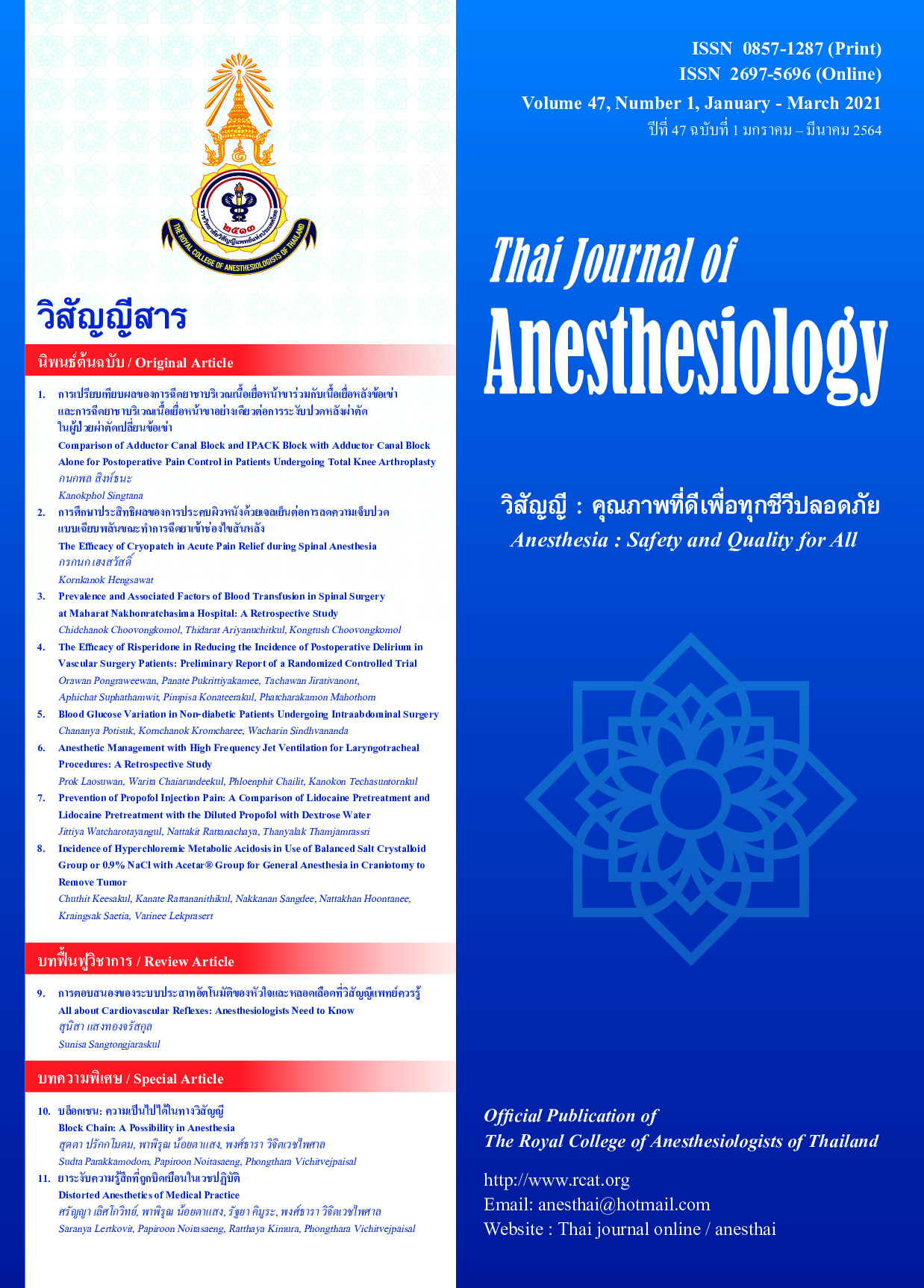The Efficacy of Cryopatch in Acute Pain Relief during Spinal Anesthesia
Main Article Content
Abstract
Background: Based on the gate control theory of pain,
pain sensation could be prevented or ameliorated,
providing “non-painful input” mitigates “painful input” at the
spinal cord level before reaching the brain level. We aim
to study the efficacy of cryopatch in acute pain control
before local infiltration during spinal anesthesia.
Methods: 70 patients undergoing elective cesarean
section were enrolled at Buriram hospital and
randomized to 2 groups. The study group received
cryopatch (35 patients) and thecontrol group received
room-temperature gel pad (35 patients) both of which
applied to the skin before local infiltration. Pain score,
satisfaction score, blood pressure, and heart rate were
measured before and after spinal anesthesia.
Results: Mean pain score is reduced significantly with
cryopatch use group compared to the control (5.68 VS
3.14, p-value: <0.001) as well as satisfaction score of the
patients (9.11 VS 7.8, p-value: <0.001). The change of the
heart rate before and after spinal needle insertion in study
group was not significantly different (95.82 VS 91.51,
p-value: 0.117) but significantly different in control group
(96.65 VS 105.82, p-value: <0.001). However, there is
significant difference in the change of blood pressure in
study group (89.37 VS 87.94 mmHg, p-value: 0.492) and
control group (89.14 VS 91.80, p-value: 0.090).
Conclusion: Cryopatchfollowed by local infiltration is
effective in acute pain control during spinal anesthesia.Additional study to evaluate the short-term complication
and cost-effectiveness is warrant.
Article Details
References
Science 1965;150(3699):971-9.
2. Orbach-Zinger S, Aviram A, Fireman S, et al. Severe pain
during local infiltration for spinal anaesthesia predicts
post-caesarean pain. Eur J Pain 2015;19:1382-8.
3. Panchamedithee N, Sangmanee W, Petcharat N. The effect
of refrigerated cold-hot pack compression in minimizing pain
among pediatric patients during receiving cloxacillin
intravenous injection. Songkla Med J 2003;21:130-6.
4. Bastami M, Azadi A, Mayel M. The use of ice pack for pain
associated with arterial punctures. J Clin Diagn Res 2015;
(8):JC07-9.
5. Cavazos-Rehg PA , Krauss MJ, Spitznagel EL, et al.
Maternal age and risk of labor and delivery complications.
Matern Child Health J 2015; 19:1202-11.
6. Dykstra JH, Hill HM, Miller MG, Cheatham CC, Michael TJ,
Baker RJ. Comparisons of cubed ice, crushed ice, and
wetted ice on intramuscular and surface temperature
change. J Athl Train 2009;44:136-41.
7. Johnson C. Measuring pain; visual analog scale versus
numeric pain scale: what is the difference? J Chiropr Med
Winter 2005;4:43-4.
8. Paul GK, Pal P. Nerve conduction study. In: Paul GK, Pravati,
editors. Text book of practical physiology. 2nd ed. Hyderabad:
Universities Press; 2003: p228.
9. Reid G, Babes A, Pluteanu F. A cold and menthol-activated
current in rate dorsal root ganglion neurons: properties and
role in cold transduction. J Physiol 2002;545:595-614.
10. Kaur B, Kaur S, Yaddanapudi LN, Singh NV. Comparison
between invasive and noninvasive blood pressure
measurements in critically ill patients receiving inotropes.
Blood Press Monit 2019;24:24-9.
11. Weiner R, Ryan E, Yohannes-Tomicich J.Arterial line
monitoring and placement. In: Oropello JM, Pastores SM,
Kvetan V, editors. Critical Care. Beijing: McGraw-Hill
Education; 2017.
12. Joffe R, Duff J, Guerra GG, Pugh J, Joffe AR. The accuracy
of blood pressure measured by arterial line and non-Invasive
cuff in critically Ill children. Crit Care 2016;20:177.


